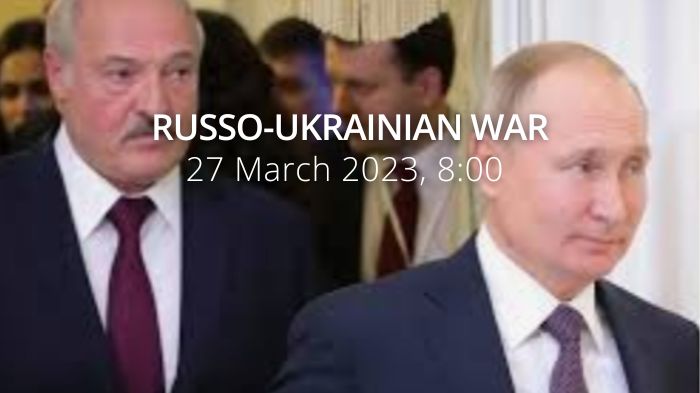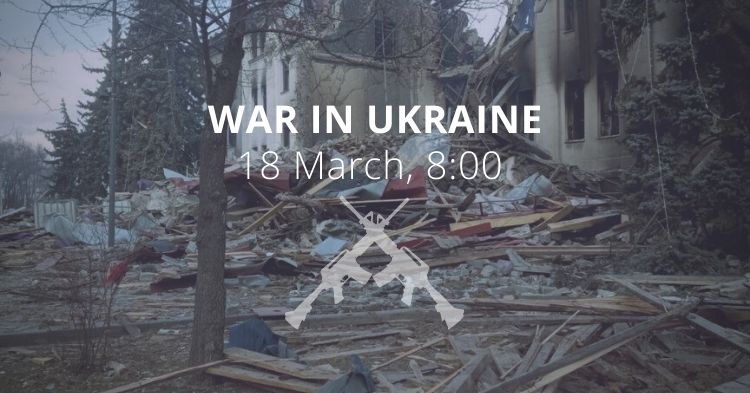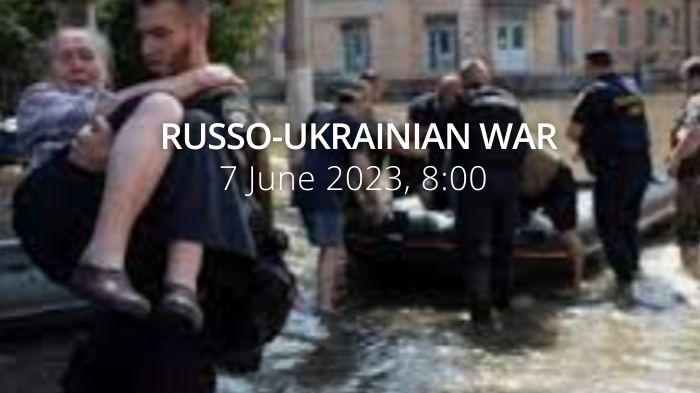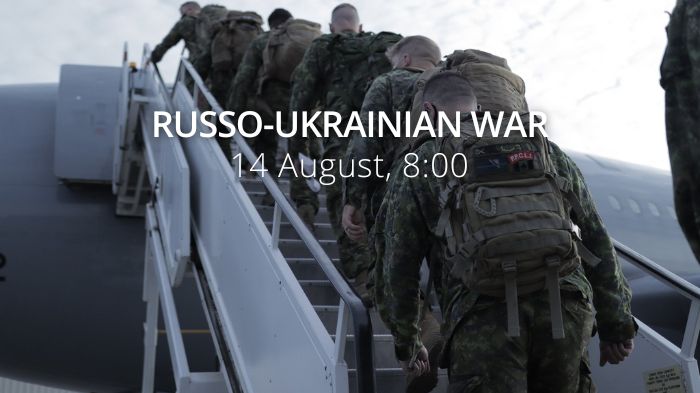Putin to deploy tactical nuclear weapons on the territory of Belarus. Ukraine demands an urgent UN Security Council meeting regarding the deployment of nuclear weapons in Belarus. IAEA Director General to visit Zaporizhzhia NPP next week.
Russia has struck a deal with neighboring Belarus to station tactical nuclear weapons on its territory, Russian President Putin claimedhttps://t.co/uX4JVKunz1
— Euromaidan Press (@EuromaidanPress) March 26, 2023
Daily overview — Summary report, March 27
A map of the approximate situation on the ground in Ukraine as of 00:00 UTC 27/03/23. pic.twitter.com/jZ3AfLEsvP
— War Mapper (@War_Mapper) March 26, 2023
The General Staff’s operational update regarding the Russian invasion as of 18.00 pm, March 27, 2023 is in the dropdown menu below:
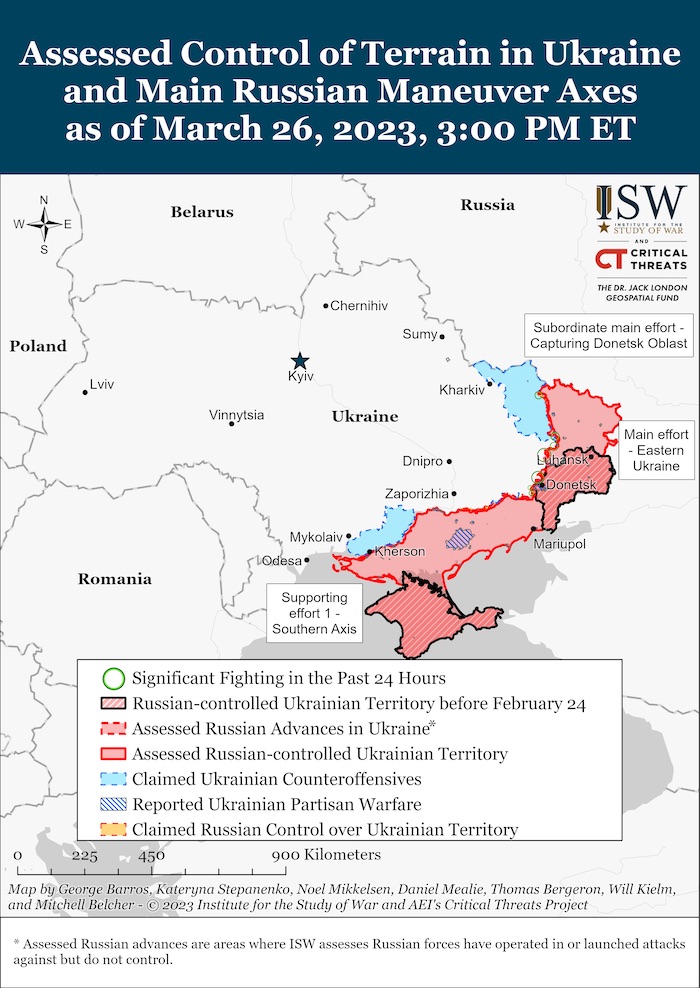
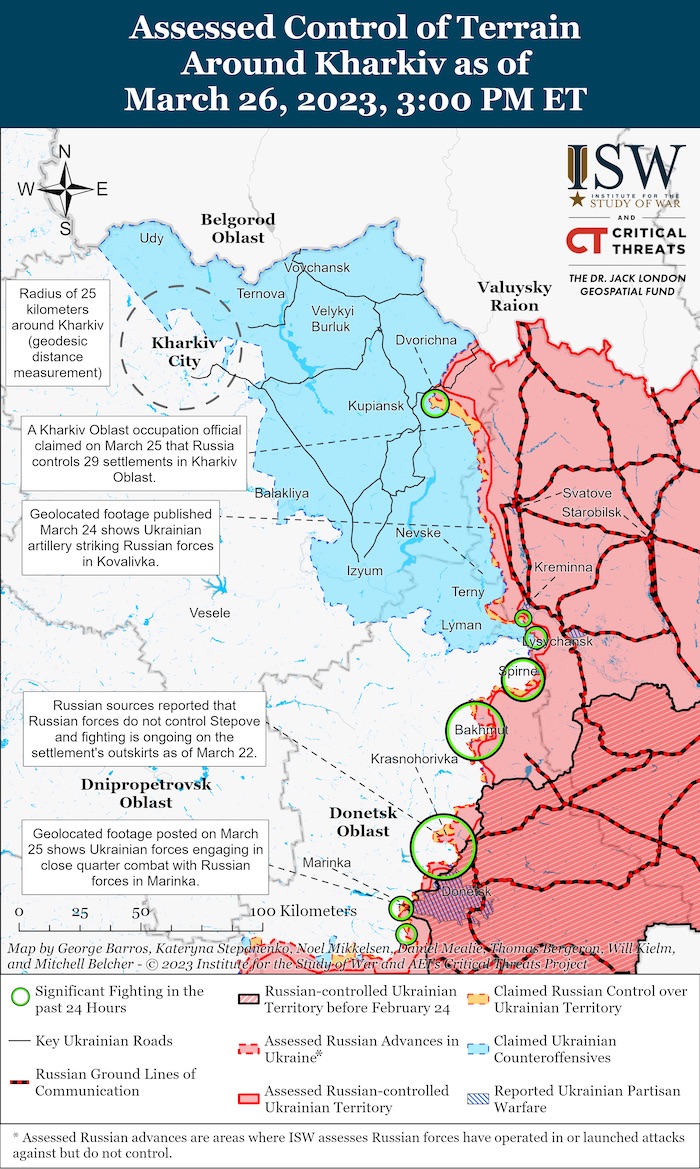
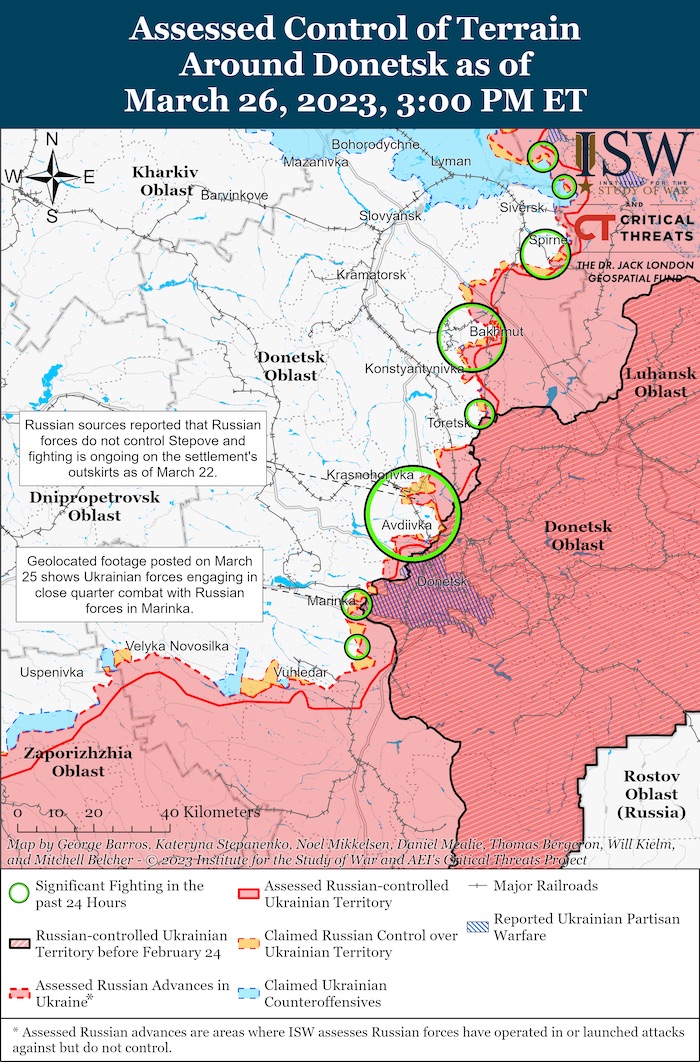
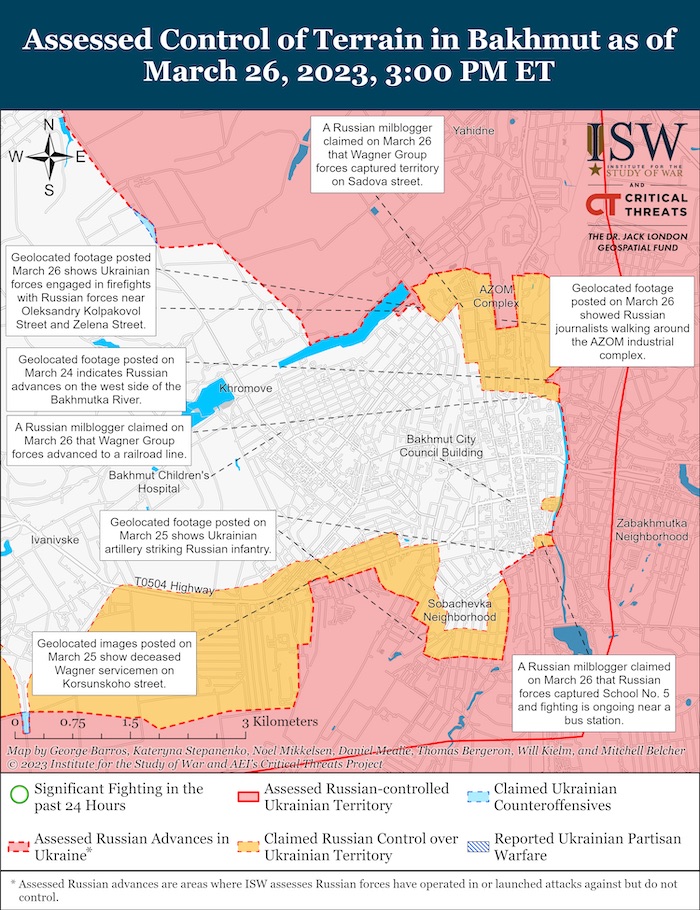
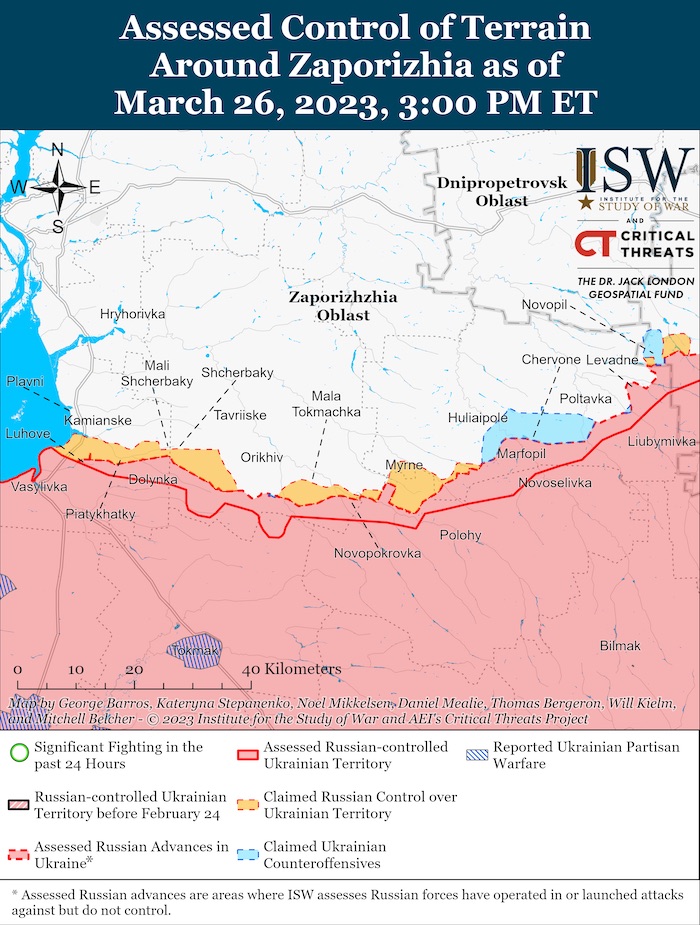
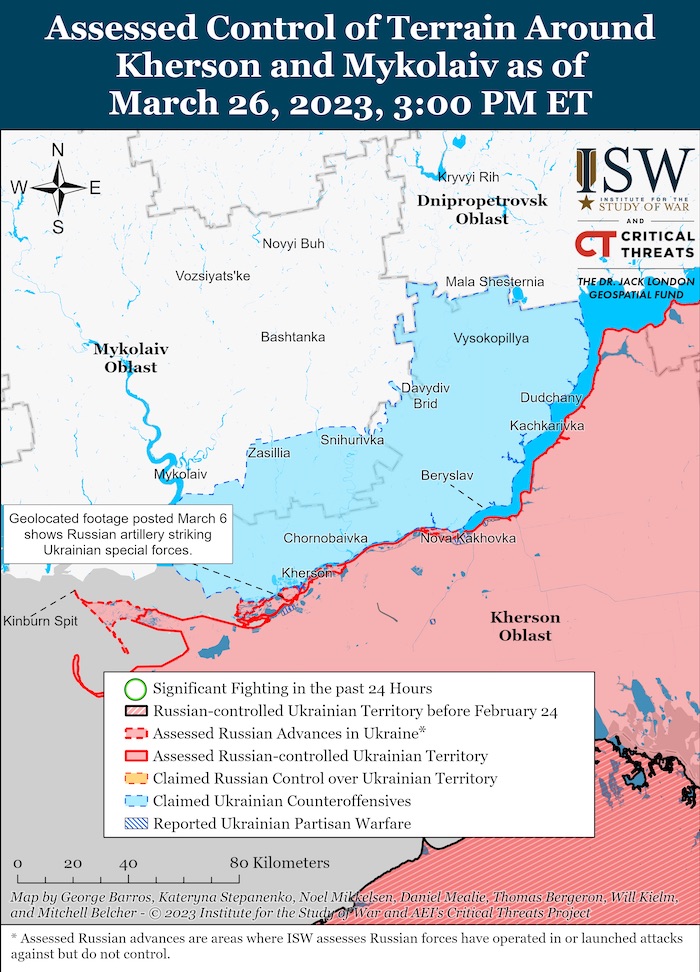
Military Updates
Ukraine liquidates Russian commander responsible for deaths of 366 country’s defenders in 2014. Ukraine has liquidated Russian commander Dmitry Lysitsky, who ordered the killing of Ukrainian defenders who tried to break through the Russian encirclement of Ilovaisk in 2014, Ukrainian military journalist Yuriy Butusov has reported. According to him, the elimination of the Russian commander was a part of the revenge operation for the Ilovaisk massacre, in which 366 Ukrainian soldiers were killed, nearly 450 wounded, and 300 imprisoned during the battle for Donbas.
Russian troops are launching intensive air attacks on Ukraine’s frontline city of Avdiivka. Russian troops are launching intensive air attacks on Ukraine’s frontline city of Avdiivka, where Ukrainian troops are holding defense in a semicircle, almost like in the Bakhmut direction. In particular, on 26 March, Russians launched several missile attacks and destroyed residential buildings, head of Presidential Office Andriy Yermak informed. According to preliminary information, there are no casualties since only 6% of the pre-war population remains in the city where 32,000 used to live.
According to British Defence Intelligence, (last 48 hours):
https://twitter.com/DefenceHQ/status/1640288409615847426
- On 22 March 2023, at least three uncrewed surface vessels (USV) and one uncrewed aerial vehicle reportedly attempted to strike the Russian naval base of Sevastopol, in occupied Crimea.
- Open source reports suggest that one USV was stopped by defensive booms, while two were destroyed in the harbour. Russian officials said that no Russian vessels had been damaged. A previous USV attack on Sevastopol on 29 October 2022 reportedly damaged the minesweeper Ivan Golubets and the frigate Admiral Makarov.
- Even though the new attacks likely failed to damage any military assets, the USV threat likely continues to constrain operations of Russia’s Black Sea Fleet.
Losses of the Russian army
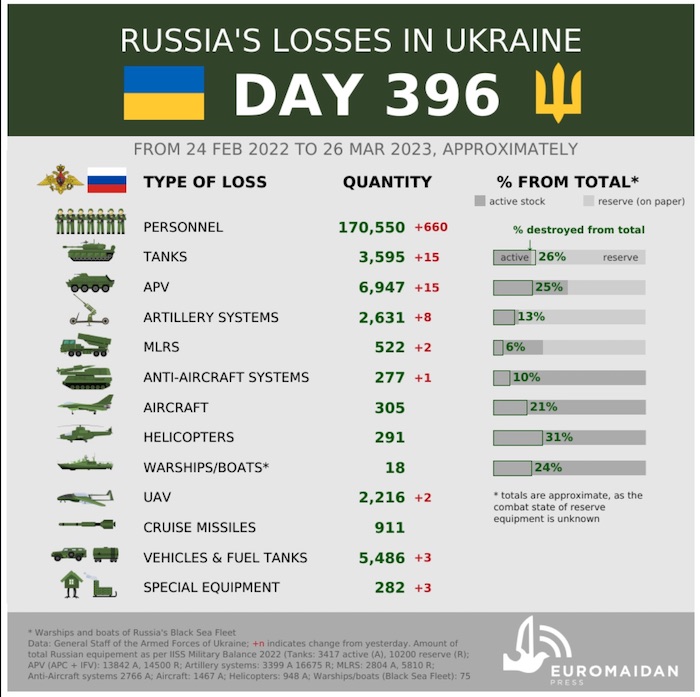
Humanitarian
https://twitter.com/EuromaidanPress/status/1640076837786116098
Trostianets city marks the anniversary of its liberation from Russian troops. Russian troops entered the town of Trostianets in Sumy Oblast on 1 March 2022. On 26 March, the Ukrainian Army cleaned Trostianets from Russian invaders. Today, the city marks the anniversary of its liberation from the occupiers. During a speech dedicated to the events, Oleg Nemchinov, the Minister of the Cabinet of Ministers, praised the bravery of the people of Trostianets, saying, “Trostianets is not just a hero city but a city of heroes!”
https://twitter.com/EuromaidanPress/status/1640061371684454403
Three Polish volunteer soldiers killed fighting Russian forces in Ukraine. Three Polish volunteer soldiers who fought against Russian troops in the Ukrainian Army were killed the last week, the minister of the Polish Prime Minister’s Office, Michal Dworczyk, said. “In the morning, in a hospital in Dnipro, a severely injured Polish volunteer died. It’s a tragic week – a total of three of our compatriots fighting on the side of Ukraine have been killed,” the minister informed.
5 Ukrainian civilians killed, 25 injured in Russian shelling over 24 hours. Russian troops shelled Donetsk, Kherson, Sumy, Dnipropetrovsk, Luhansk, Chernihiv, Kharkiv, and Zaporizhzhia oblast from artillery, surface-to-air missile systems S-300, mortars, tactical aircraft, and strike unmanned aerial vehicle Lancet. In addition, 63 infrastructure objects were damaged in the attacks.
City center of occupied by Russia Mariupol in March 2023.
About 100,000 people are currently living in the city where nearly 500,000 lived before the war.
Source: advisor to Mariupol mayor Petro Andriushchenko. https://t.co/Zf3a2hzgz2 pic.twitter.com/MQGHVEHQGa— Euromaidan Press (@EuromaidanPress) March 26, 2023
Environmental
IAEA Director General to visit Zaporizhzhia NPP next week. The Director General of the International Atomic Energy Agency (IAEA), Rafael Mariano Grossi, plans to visit the Zaporizhzhia nuclear power plant (NPP), as reported by the IAEA. Director General Grossi will visit the nuclear power plant for the second time during the war. It is also the first time since establishing a permanent presence of IAEA experts on 1 September 2022.
Legal
The Russians “treat torture as entertainment” – freed Enerhodar Deputy Mayor. Ivan Samoidiuk, First Deputy Mayor of Enerhodar, was the first of many Ukrainian civilians from Enerhodar to be taken prisoner by the Russian invaders after they seized control of the city on 4 March 2022. Samoidiuk, who will shortly turn 60, spent 333 days in Russian captivity, with almost half of that time in solitary confinement, before being released, on 17 February 2023, as part of an exchange of prisoners. In an interview to Hromadske Radio, he spoke of the treatment the invaders mete out to civilian hostages. The thing he finds most incomprehensible, he says, is “how people can get pleasure out of torture. They don’t treat it as work, they treat it as entertainment, getting pleasure out of it.”
Ukrainians who resist Russian passportization face cruel torture – Center for National Resistance. Ukraine’s Center for National Resistance reports that Russian occupiers in Kherson Oblast are resorting to physical violence to coerce Ukrainian citizens into obtaining Russian passports. The residents of the temporarily occupied territories continue to resist the forced passportization, the Center reports. The issuance of Russian passports is too low, and the occupation administrations receive systematic reprimands from their Kremlin curators.
Crimean lecturer dismissed, beaten and jailed for Ukrainian songs gets new sentence over a post about Russia’s killing of civilians. A ‘court’ in occupied Crimea has found Andriy Bielozierov guilty of ‘repeated public actions aimed at discrediting Russia’s armed forces’ through a post on social media about Russia’s bombing and killing of civilians. There was nothing at all untruthful in the post, but nor is this required under the draconian silencing norms rushed into law shortly after Russia’s full-scale invasion of Ukraine. These were the first criminal charges against the former lecturer after two prosecutions, one under the analogous administrative charge of ‘discrediting the Russian armed forces’, for Ukrainian songs. Bielozierov had been held under house arrest since December 2022 and there seemed grounds for fearing a term of imprisonment of up to five years. Instead, ‘judge’ Kirill Chinov from the occupation ‘Central district court’ in Simferopol imposed a steep 100 thousand rouble fine, and also banned Bielozierov from administering social media sites for two years. News of the sentence was reported by the Russian human rights initiative OVD.Info, whose lawyer represented Bielozierov.
Support
https://twitter.com/EuromaidanPress/status/1640013991610073090
Second group of Ukrainian artillery recruits finishing training on the UK AS90 155mm self-propelled guns.On January 15, Britain confirmed plans to transfer a squadron of 14 Challenger 2 tanks to Ukraine, a battery of eight AS90 self-propelled guns at “high readiness” and two batteries at “varying states of readiness.” A group of Ukrainian military personnel arrived in Britain for training on AS90 self-propelled guns at the beginning of February. The Ukrainian artillery soldiers have backgrounds ranging from experienced artillery soldiers to little or no military experience.
North Macedonia to offer Ukraine 12 Mi-24 helicopters, its Defense Minister says. The Defense Minister of North Macedonia, Slavjanka Petrovska, announced that the Macedonian government will propose to transfer 12 Mi-24 helicopters to Ukraine. She made the statement during an interview on Alsat TV, which was quoted by Nezavisen. Petrovska noted that the General Staff of North Macedonia had completed an analysis of whether the country could provide Mi-24 helicopters to Ukraine. She said that the proposal for the transfer would be brought to the government on Wednesday. She emphasized that the decision would not affect the combat readiness of the North Macedonian army.
The problem with how the West is supporting Ukraine – opinion
"Wars are won or lost well behind the front lines. Allies should arm Ukrainians accordingly" – @PhillipsPOBrienhttps://t.co/3EfgYhrJht
— Euromaidan Press (@EuromaidanPress) March 26, 2023
New Developments
Ukraine demands urgent UN Security Council meeting regarding the deployment of nuclear weapons in Belarus. The latest statements of the Russian Federation regarding the intention to deploy tactical nuclear weapons on the territory of Belarus “are another provocative step by the criminal Putin regime, which undermines the principles of the Treaty on the Non-Proliferation of Nuclear Weapons,” the statement of Ukraine’s Ministry of Foreign affairs reads. It also undermines “the architecture of nuclear disarmament and the international security system as a whole,” the ministry adds.
As long as President Putin has nuclear weapons, Europe cannot be safe – ICAN. The International Campaign to Abolish Nuclear Weapons has condemned Russian president Putin’s announcement on placing nuclear weapons in Belarus, Guardian citing him:“As long as President Putin has nuclear weapons, Europe cannot be safe. He justfies this dangerous escalation by citing decades of NATO nuclear sharing. As long as countries continue their complicity in considering nuclear weapons as anything other than a global problem, this helps give Putin cover to get away with this kind of behaviour,” ICAN’s interim executive director Daniel Hoegsta said in a statement.
Olympic Committee and Shooting Sport Federation plan to allow participation of Russian shooters in Asian events and the Olympics. International Shooting Sport Federation (ISSF) & the International Olympic Committee (IOC) are about to agree on the participation of Russian shooters in Asian events. They also plan to open the pathway to the Olympics for Russian athletes, said the International Shooting Federation president Luciano Rossi.
Assessment
- On the war.
The Institute for the Study of War has made the following assessment as of March 26, 2022:
ISW is publishing an abbreviated campaign update today, March 26. This report discusses Russian President Vladimir Putin’s continued efforts to seek complete victory in Ukraine, which he appears confident that he can attain over time. Putin seems to reject the idea increasingly prevalent in Western discourse that the current military realities require or support a negotiated resolution of the conflict. Neither Ukraine nor the West has persuaded him that he must consider accepting any sort of off-ramp or compromise settlement. Putin instead remains focused on achieving his initial war aims through protracted conflict in which he wins either by imposing his will on Ukraine by force or by breaking Ukraine’s will following the West’s abandonment of Kyiv. Multiple successful Ukrainian counter-offensives are almost certainly necessary but not sufficient either to persuade Putin to negotiate on acceptable terms or to create military conditions on the ground favorable enough to Ukraine and the West that continued or renewed Russian attacks pose acceptable threats to Ukraine or NATO.
The outcomes of wars often are, in fact, determined on the battlefield with negotiations that merely ratify military realities. Putin likely has one such example vividly in his mind—World War II in Europe. That war ended only when Allied forces had completely defeated the German military and Soviet troops stood in the wreckage of Berlin. Japan surrendered a few months later after the US had demonstrated what appeared to be the ability to destroy the country completely—and only after the Japanese military had lost the ability to do more than impose casualties on the US in the process of losing. Going further back in history the peaces that ended the three Wars of German Unification, the American Civil War, and the Napoleonic Wars also merely ratified realities created by decisive military victories. Even the most recently ended war adhered to this pattern. The US withdrawal from Afghanistan was followed by a decisive Taliban military victory that has ended that conflict (for now) without any formal treaty or accord ratifying this outcome. History offers many counter-examples, to be sure, including the Dayton Accords that ended the Bosnian conflict and the resolution of the 1973 Arab-Israeli War. But it is simply not the case that all wars end in negotiated settlements, particularly if by “negotiated settlements” is meant mutual recognition of the impossibility of achieving desired aims through military force.
Putin initiated the current war and is the key actor who must decide that he cannot achieve his aims by military power and must instead engage in a negotiated resolution of the conflict if the war is to end in this fashion. The war will protract as long as Putin believes that he can impose his will on Ukraine by fighting or by breaking the Ukrainians’ will to fight following their abandonment by the West.
Putin continues to make clear by word and deed that he has come to no such conclusion yet despite the failures of his major military efforts this winter. His efforts to freeze Ukraine and Europe into surrendering over the winter came to nothing, and the Russian winter-spring offensives that were supposed to secure the borders of Luhansk and Donetsk oblasts are culminating.[1] The Russian military has committed the overwhelming majority of the reportedly 300,000 reservists mobilized in Fall 2022 as well as the 40,000 convicts recruited into the Wagner Private Military Company (PMC) into a multi-divisional offensive all along the line in Luhansk and Donetsk oblasts.[2] The results of that effort are deeply unimpressive. Russian forces gained no significant terrain in Luhansk. Wagner troops have taken part of Bakhmut City and conducted an incomplete turning movement that has so far failed to persuade Ukrainian commanders to withdraw from the Bakhmut pocket.[3] Donetsk People’s Republic (DNR) forces, now reinforced by conventional Russian troops, have conducted a similarly incomplete turning movement around Avdiivka.[4] Offensives against Vuhledar in western Donetsk Oblast have made effectively no gains at staggering costs in manpower and materiel.[5] The Russian milblogger space and Russian, Ukrainian, and Western media are full of discussions of the upcoming Ukrainian counter-offensive, about which the only real questions appear to be when and where it will occur.[6] This would be an appropriate moment for Putin to conclude that Russia cannot impose its will on Ukraine by force and that he must seek a compromise settlement. He has clearly come to no such conclusion, however.
Putin is instead doubling down on his commitment to overpower Ukraine militarily and/or protract the war by mobilizing Russia’s defense industrial base and renewing various crypto-mobilization schemes to generate renewed combat power. Putin’s March 25 speech continued a months-long effort to mobilize Russian military industry for a protracted war.[7] That effort and his speech also aim to portray Russia (falsely) as the modern incarnation of Stalin’s Soviet Union able to overwhelm its enemies with unstoppable masses of men and materiel despite Putin’s manifest unwillingness actually to put Russia fully on a war footing. Russian Defense Minister Sergei Shoigu began this effort at the end of 2022 and has continued it through this year, and Putin has been amplifying it.[8] The Russians clearly are attempting to mobilize their military industry and will surely generate some improvements. The exaggerated claims and unrealistic goals that Putin and Shoigu have made and set are intended in part to portray greater strength and potential than Russia has. They do not, however, reflect the challenges Russia faces in acquiring essential war materiel in the face of Western sanctions and in shortages of skilled labor. The latter challenge is made more acute by the need for Russia to balance mobilizing young men to fight and keeping them in the workforce.[9] That Putin should be mobilizing Russia’s defense industry now is surprising only in that it took him this long to start. The fact that he is not accompanying this mobilization with any suggestion that he would consider a compromise peace—particularly after Chinese Premier Xi Jinping appeared to offer to help negotiate one during a high-profile and dramatic visit to Moscow—indicates that Putin remains committed to achieving his aims by force.[10]
The continuing of Russian offensive operations around Bakhmut and Avdiivka, as well as along the Luhansk and western Donetsk front lines, is a further indicator that Putin remains committed to victory in a protracted war whose outcome is determined in large part by military realities on the ground. These attacks have now become not merely pointless, but actually harmful to Russian preparations for the next phase of this war, which will revolve around the upcoming Ukrainian counter-offensive. Russian forces may or may not be able to drive Ukrainian troops out of Avdiivka or Bakhmut, but they will gain no significant operational advantage from doing either because they lack the ability to exploit such advances. The Russians appear to have little likelihood of making any gains that are even tactically significant in western Donetsk or on most of the Luhansk line—yet attacks in all these areas continue.
Putin’s continuation of these Russian offensive operations in the current operational and strategic context amounts to strategic malfeasance. It expends scarce Russian combat power in pursuit of operationally meaningless gains rather than setting conditions to receive and defeat a Ukrainian counter-offensive that everyone appears to expect imminently.
Putin’s stubbornness in clinging to these offensive operations could make sense, however, in a protracted conflict during which Western support for Ukraine wanes or ends. Putin might even mean these operations to set conditions for a negotiated settlement on terms he has already articulated that include international recognition of Russia’s annexation of all of Donetsk, Luhansk, Zaporizhzhia, and Kherson oblasts; Ukrainian “neutrality;” the “de-militarization” of Ukraine; and the “de-Nazification” of the Ukrainian government. He may be pressing his commanders to continue attacks that are increasingly pointless in the short term because he recognizes that he can only hope to make good his claims to unoccupied areas of the four oblasts he has annexed if his forces actually take them. He may, in this sense, indeed be seeking to set conditions for a negotiated settlement. In that case, however, it becomes apparent that he must still believe that he can impose his desired resolution of the conflict on Ukraine and the West by military force—or by convincing Ukraine to surrender—and that he is unwilling to accept a resolution short of his stated aims (which include territories that Russian forces do not yet control) at this time.
A successful series of Ukrainian counter-offensives, not just one, is thus almost certainly necessary but not sufficient to persuade Putin to enter negotiations on terms other than the achievement of all of his stated objectives. Ukrainian forces must show that they can do what Russian forces cannot, namely change the realities on the ground through military action. They must further damage Russian military power in Ukraine to the point at which it becomes clear to Putin and the inner circle that supports him in this war that the Russian armed forces cannot hope to improve the outcome of the war by continued fighting. Multiple major Ukrainian operational-level victories are therefore likely essential to creating any prospect of a negotiated settlement of the current conflict or forcing Putin to accept unfavorable military realities absent a formal settlement.
There is reason to expect that Ukrainian forces can, in fact, make gains through counter-offensives. Ukraine has launched two major counter-offensive operations in this war, not counting the voluntary withdrawal of Russian forces from around Kyiv. Both were successful in retaking large areas, first in Kharkiv and then in western Kherson.[11] Various analysts have expressed various opinions about whether Ukrainian forces can penetrate prepared Russian defensive positions and raised other concerns about the prospects for Ukrainian successes. It remains the case, however, that whereas Russian force have demonstrated that they cannot make significant gains at this stage of the war, Ukrainian forces have yet to fail in such an attempt.
It is far from clear that Putin ever will accept these military realities, however. He may resolve to continue fighting, with or without a pause, as long as it takes to achieve all his aims. His rhetoric and actions, as well as his past patterns, certainly suggest this possibility. A negotiated settlement may therefore be unattainable because Putin will not accept the reality that he cannot actually conquer Ukraine.
Ukraine and the West will have to create military realities that permit a cessation of hostilities on terms that they can effectively impose on Putin in that case. Ukrainian forces, properly supported by the collective West, can retake the terrain that is strategically vital to Ukraine’s military and economic survival and that would be essential for renewed Russian offensives on terms favorable to Moscow. ISW has assessed the operational and strategic significance of various parts of occupied Ukrainian territory and stands by that assessment.[12] There likely is a line short of the full restoration of Ukrainian control over all of occupied Ukrainian territory that could be the basis for a protracted cessation of hostilities on terms acceptable to Ukraine and the West—but that line is not close to where the current front lines stand.
It is not a given, nevertheless, that Putin will continue fighting regardless of cost until the day he dies. He has ostentatiously and surprisingly refrained from going all-in on this war from its inception. One can dismiss his failure fully to mobilize and prepare his military before the invasion because he clearly believed that the Ukrainians would not or could not fight. He has passed by multiple moments when moving to fuller mobilization had become necessary, has delayed decisions to implement even partial mobilization for far too long from Russia’s perspective, and even when he has made such decisions has sought to limit their impact on the Russian society and economy.[13] Putin’s Stalinist rhetoric aside, he has shown remarkable concern about the danger of pushing Russia too far and generating a threat to the stability of his regime. Ukraine and the West should not count on Putin’s will breaking by any means, but neither should they dismiss the possibility that he might at some point decide that the costs and risks of continuing the fight are no longer justified by the potential gains.
Putin is nevertheless putting no terms for negotiation on the table now other than Russia’s total success. He is not taking the military measures that would be prudent were he serious about seeking some negotiated off-ramp or compromise settlement. The current frontlines would set highly favorable conditions for renewed Russian invasions if Putin were offering to accept them as a ceasefire boundary—but he clearly is unwilling to do so.
The choices before Ukraine and its Western backers at this time are thus relatively straightforward. Ukraine can unilaterally cease fighting even as Russian attacks by ground and air continue, which would lead to disastrous defeat (and which almost no one is advocating). Ukrainian forces can continue fighting in a very constrained way seeking only to hold what they now have, which will encourage Putin to continue his efforts to pursue outright military victory. Or they can launch successive counter-offensive operations with the twin aims of persuading Putin to accept a negotiated compromise or of creating military realities sufficiently favorable to Ukraine that Kyiv and its Western allies can then effectively freeze the conflict on their own regardless of Putin’s decisions. Those are the options facing Ukraine and the West as long as Putin continues to believe that he can impose his will by force of Russian arms over however long a period he is willing to fight.
Key inflections in ongoing military operations on March 26:
- Ukrainian Deputy Defense Minister Hanna Maliar called for informational silence regarding a potential Ukrainian counteroffensive.[14]
- Russian milbloggers largely amplified and praised Russian President Vladimir Putin’s March 25 information operations.[15] One milblogger claimed that the deployment of nuclear weapons does not change Russia’s military situation in Ukraine or need to defend against a future Ukrainian counteroffensive, however.[16]
- Russian forces conducted limited ground attacks on the Svatove-Kreminna line.[17] Ukrainian Eastern Group of Forces Spokesperson Colonel Serhiy Cherevaty stated that Russian and Ukrainian forces fought 10 battles in the Kupiansk-Lyman direction.[18]
- Russian forces continued attacking Bakhmut and its environs and made marginal gains within the city.[19] Russian sources claimed that Wagner Group forces cleared the AZOM plant in northern Bakhmut.[20]
- Russian forces continued attacking along the Avdiivka-Donetsk City line and made marginal gains within Marinka.[21] Ukrainian intelligence stated that Wagner Group forces may arrive in the Avdiivka direction.[22]
- Russian forces continued routine fire against areas in Zaporizhzhia, Kherson, and Dnipropetrovsk oblasts.[23] Head of the Ukrainian United Coordination Press Center of the Southern Defense Forces Nataliya Humenyuk stated that Russian forces in southern Ukraine lack adequate supplies of missiles and drones.[24]
- Russian sources reported the formation of the “Uragan” volunteer battalion of the irregular formation 1st “Wolves” Sabotage and Reconnaissance Brigade, which operates in the Avdiivka area.[25]
- United Russia Secretary Andrey Turchak announced the proposal of a draft law on March 24 that would allow families of employees of the Ministry of Internal Affairs (MVD) who died in the war to be eligible to receive a one-time housing payment.[26]
- The Ukrainian General Staff reported that Russian occupation authorities in Berdiansk in occupied Zaporizhzhia Oblast are requiring locals to obtain passes from the occupation administration by April 1 in order to move around occupied Zaporizhzhia Oblast.[27]
By blockading Ukraine’s Black Sea ports, Russia seeks to bankrupt Ukraine and overcome int'l opposition to its war by weaponizing agricultural exports, doing so in clear violation of international maritime law" – MP @GoncharenkoUahttps://t.co/qndra3JG0z
— Euromaidan Press (@EuromaidanPress) March 26, 2023




